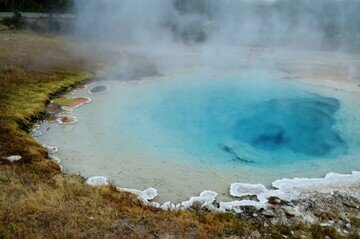
Hot springs are a source of deep groundwater and can be found at the surface. Credit: Amy Hamerly/Unsplash
Recent research has more than doubled the volume of ancient, salty underground water stored deep in Earth's crust.
Within the top 2 km (1.2 mile) of Earth's crust, there are approximately 24 million cubic kilometers (5.8 cubit miles) worth of groundwater. This is the groundwater we use for irrigation and drinking. Below that, there are huge reservoirs of salt, some of which is hundreds of millions to more then a billion years old, and they are locked away in rocks. The question was, "How much?"
According to a new study, there is approximately 20 million cubic kilometers worth of deep groundwater. This would be enough water to fill nearly 4,800 Grand Canyons. The new research, which is based on previous estimates of shallower groundwater, shows that underground water is the largest source of water on the planet, with 44 million cubic kilometers. This volume surpasses the volume of Earth’s ice sheets.
Grant Ferguson, a hydrogeologist from the University of Saskatchewan, was the lead author of the study published in Geophysical Research Letters by the AGU. This journal publishes short, high-impact reports that have immediate implications for all Earth and space sciences.
This deep groundwater can't be used for drinking water or irrigation. However, it is necessary to accurately estimate the volume and connectivity of this groundwater for safe planning subsurface activities such as hydrogen production, storage of nuclear waste, and carbon sequestration. To prevent contamination of shallow, usable groundwater, potential storage sites must be large enough and well-sealed from surface aquifers.
When comparing the sizes of the planet's water reservoirs, it is clear that groundwaterboth shallow, fresh water, and deeper, salty, makes up approximately 60% of land's water, while ice sheet make up close to 40%. The size of the deep-saline groundwater reservoir was nearly doubled by the new study. Credit: AGU/Geophysical Research Letters
These deep reservoirs can be disengaged from shallow aquifers so in some cases the brine may have been held for geologic periods. These ancient waters can provide insights into Earth's past conditions and may even support active microbial ecosystems. These deep-subsurface biological communities provide information for mission planning to explore potential habitable zones in other parts of the solar system.
Deep, salty waters
Scientists can calculate the volume of deep groundwater by using different rock types. Each type has a different porosity, or amount of empty space. The previous estimates of deep groundwater depths between 2 and 10 km only considered crystalline rocks that have low porosity like granite. They also added volume from buried sedimentary rock, which is more porous than crystalline, to their estimate of 8 million cubic kilometers. This is 339 times more volume than Lake Baikal.
Groundwater that is deep within rocks with low permeabilities and many times in rock layers, can't flow or circulate to the surface. This greatly reduces the planet's hydrologic cycle. Salty water is up to 25% more dense than seawater. This makes it difficult to "flush out". However, high elevations near low elevations can create pressure differences that allow shallow water to flow further. This is similar to the pressure caused by water towers. Only a handful of places in North America have been confirmed to have surface waters that circulated further than 2 km. The deepest circulation is located near the Rocky Mountains, northwestern Wyoming, and southern Alberta.
Although it is vast, the deep groundwater won't solve the worlds water shortages. According to the study's authors, it is impossible to use this brine for irrigation or drinking water.
Scott Jasechko, a University of California-Santa Barbara hydrologist, said that "we still have this precious and finite amount of groundwater on Earth that we must protect." He was not part of the new study.
There is a way to live your life
For storage of waste fluids and carbon sequestration, deep groundwater is essential. Scientists can better determine the safety of subsurface storage by determining how large and how far they are from shallower groundwater.
These new discoveries could aid in the search for extraterrestrial living by allowing scientists to study similar environments on other planets where microbial communities might exist. Microbial life can survive in complex environments. These include extremely acidic and high temperatures. Microbes have been found as far as 3.6 km (2.2 miles) below the Earth's continental crust.
Jennifer Biddle, a University of Delaware microbiologist, said that doubling deep groundwater estimates would mean doubling the size of the mysterious deep microbial biosphere.
Biddle stated that if there is liquid water, then there is a good chance there are microbes. Subsurface organisms can survive off water and rocks, rather than sunlight and water. They can live on [chemicals] in these microbial systems. Microbes can use any chemicals they find that can be combined in a way that generates energy to live as long as there is enough.
This flexibility could mean that Martian microbes could hide in deep crustal groundwater on the red planet, if it is there.
Biddle stated that "if there is deep water on Mars, it's possible that that deep groundwater could potentially contain remnant microbes" similar to Earth's ancient water. "So deep groundwater habitats could serve as great analogs to other planet bodies, such as Mars or Enceladusa moon Saturn that definitely have deep water."
Grant Ferguson et. al., Crustal Groundwater volumes greater than previously thought, Geophysical Research letters (2021). Information for Journal: Geophysical Research Letters Grant Ferguson and co, Crustal Groundwater volumes greater than previously thought, (2021). DOI: 10.1029/2021GL093549
